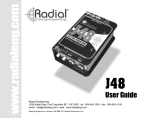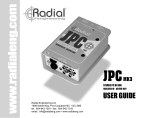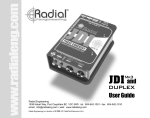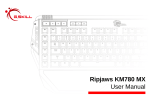Download User Guide - Radial Engineering
Transcript
www.radialeng.com JPC User Guide Radial Engineering 1638 Kebet Way, Port Coquitlam BC V3C 5W9 tel: 604-942-1001 • fax: 604-942-1010 email: [email protected] • web: www.radialeng.com Radial Engineering is a division of C•TEC (JP CableTek Electronics Ltd.) JPC USER GUIDE Consumer To Pro Stereo Direct Box TABLE OF CONTENTS PAGE Introduction ............................................................................. Input & output panel feature set .............................................. Inside view & features ............................................................. Design concept ....................................................................... Development ........................................................................... Block diagram and specifications ............................................ Frequently asked questions .................................................... Warranty .................................................................................. 1 2 3 4 5 8 9 Back cover True to the Music Radial Engineering 1638 Kebet Way, Port Coquitlam BC V3C 5W9 tel: 604-942-1001 • fax: 604-942-1010 email: [email protected] • web: www.radialeng.com Radial Engineering Ltd. is a division of C•TEC (JP CableTek Electronics Ltd.) Features and specifications are subject to change without notice. JPC - Manual V1.0 part#: R800-9631-00 True to the Music INTRODUCTION Congratulations on your purchase of the Radial JPC Stereo Direct Box The Radial JPC™ is an active ‘consumer to pro’ stereo direct box specifically developed for computer sound cards and electronic media. It features 1/4” TRS, 1/8” TRS and dual stereo RCA input connectors. All of which may be used as inputs, or thru-puts. The XLR outputs are transformer isolated to eradicate hum and buzz caused by ground loops. The JPC is 48V phantom powered, eliminating the need for batteries while allowing long cable runs. The compact yet ultra-rugged bookend design allows the Radial JPC to be used in the most demanding rental and touring environments. We invite you to read through this manual before using your Radial J48 so that you can maximize it’s potential. Please log onto www.radialeng.com for further details and updates. We also invite you to forward any comments, questions or suggestions to [email protected]. We love to hear from you! Enjoy. Radial Engineering 1 JPC User Guide True to the Music INPUT PANEL FEATURES OUTPUT PANEL FEATURES 1. –10dB pad reduces the level going into the JPC from loud sources that could overload the circuit and cause distortion. 6. Stereo ground lift toggle switch (on side). 7. Twin XLR male output connectors follow AES standard with Pin-1 ground and Pin-2 hot. 2. 48V Power on LEDs lets you know that phantom has been turned on and is powering the two channels. 8. No-slip full rubber bottom provides mechanical isolation, electrical insulation and ‘stay-put-ability’! 3. 1/4” TRS connecter that will also work with ¼” mono instrument signals! 9. Bookend design with baked enamel finish. 14 gauge steel outer shell creates protected zone around connectors and switches. Finished in tough baked enamel for years of great ‘looking’ performance. 4. 1/8” TRS stereo connector designed for PCs, laptops, and personal music players makes connection easy with 1/8” to 1/8” cable. 5. Stereo RCA connectors are great for connecting CD players and video machines. RCA thru-puts for flexibility. Radial Engineering 2 JPC User Guide True to the Music INSIDE VIEW 10. Isolated XLR connectors to eliminate chassis ground potential. 11. Active balanced drive circuit for long cable runs without signal loss. 12. Transformers on both inputs provide 100% isolation to eliminate hum and noise causing ground loops. 13. Military grade PC board with full surface ground plane to reduce RF noise susceptibility. 14. Long life, high cycle rated push switches for reduced maintenance. 15. Welded I-beam construction makes it impossible to torque the PC board and provides maximum resistance against cold solder joints. Radial Engineering 3 JPC User Guide True to the Music and cause solder joint failure. A full-bottom no-slip pad provides electrical insulation and mechanical isolation with plenty of ‘stay-put’ for use on hectic stages. And with its baked enamel finish, the Radial JPC will continue looking great for years! DESIGN CONCEPT The Radial JPC is a stereo direct box that has been specifically designed for use with computer sound cards and other consumer electronic products. The JPC allows these devices to be connected to a professional sound system. The JPC is unique in that it combines the advantages of transformer-isolated inputs with an active drive circuit, giving you the ‘best of both worlds’ in a compact and extremely flexible stereo package. Feature Set • Stereo direct box developed for PC sound cards • Converts –10dB consumer signals to balanced mic level • Transformer isolated inputs eliminates ground loops • Compact design is easy to deploy • 48V phantom powering eliminates batteries • Ultra rugged bookend, 14-gauge steel construction • May be rack mounted with the Radial J-Rak • 1/4”, 1/8” and RCA connection options • Unused inputs can be used as a thru-put • Built like a tank with a full 3-year warranty Transformer coupled inputs have the unique advantage of isolating the ‘source’ from the ‘destination’. This proven approach eliminates 60-cycle hum and buzz caused by socalled ground loops when two pieces of electrically powered devices are connected together. Because the active circuit does all of the impedance conversion and balancing, a dedicated 1:1 transformer can be used. This results in a hybrid design that is at once great sounding, compact and more affordable. Primary applications • Computer sound card • CD Player • DJ Mixer • DVD Audio player • I-Pod • Walkman • Cassette deck • Video player • Stereo pre-amp output As with all great designs, simplicity is a fundamental trait and the Radial JPC certainly fits the bill. A choice of 1/4”, 1/8”, and RCA input / thru-put connectors make interfacing a snap with all types of equipment. A single switch inserts a stereo –10dB pad, two power LEDs confirm 48V phantom is turned on, and a pair of XLR output connectors round out the feature set. Secondary applications • Stereo keyboard • Stereo drum machine • Stereo sampler Of course like all Radial products, the JPC is built to handle the most abusive environments. Our unique bookend design protects switches and connectors from damage while the 14 gauge steel I-beam construction eliminates outside stress that could torque the PC board Radial Engineering 4 JPC User Guide True to the Music DEVELOPMENT As with all clever products, the Radial JPC’s development stems from demands from field engineers trying to find a useful and simple solution to a problem or challenge. Today, engineers are talking full advantage of the power of media technology by integrating computers, video players and compact discs in their productions. But with the integration of ‘new technology’ comes the many challenges of connecting these ‘consumer’ devices to the world of professional audio. Thus, the obvious need for suitable interfacing equipment for consumer audio devices has spawned the development of the Radial JPC. Why not just use two direct boxes when dealing with PCs, VCRs, and CD player audio outputs? Most direct boxes and interfaces use a passive design that employs low cost instrument DI transformers to do the isolation, balancing and impedance matching. The JPC is an active device that employs the transformer for isolation only. Our active circuit performs the balancing and impedance matching and this produces better sound. For the audio engineer, interfacing computers and video equipment to a professional audio system involves dealing with several challenges: for the most part, consumer level products are outfitted with less than ideal connectors, are generally unbalanced and are notorious for causing system noise. For instance, the audio output connection from a portable PC is usually a 1/8” mini TRS (3.5mm) connector while audio from a CD player is generally an RCA connector. Although the connectors used are different the signal these consumer devices output is most likely high impedance (unbalanced) and line level (-10 db). These high impedance line level sources must be converted to balanced mic level signals in order to work alongside microphone signals in snake systems, mic splitting transformers, and consoles. The Radial JPC is outfitted with 1/8” TRS stereo input, dual stereo RCA jacks, and sports a stereo 1/4” TRS jack to make connecting a wide range of consumer products easy. The multiple connector types on the JPC eliminate the need for extra adaptors between the audio device and the JPC. A -10db pad helps address the various output levels found on consumer equipment. Some devices, like a mini MP3 player, have only a 1/8” headphone output. The -10db pad in conjunction with the units volume control can accomadate even this high output signal. To further enhance functionality, all of the input connectors are designed to act as thru-puts. This feature allows the signal from a given source to not only pass through the JPC to the XLR balanced output, but allows the system engineer to drive a secondary mixer or recorder at the same time. This would typically be used for personal monitoring, for recording a performance, to drive a second speaker system or possibly an assistive listening system. Radial Engineering 5 JPC User Guide True to the Music The JPC Active Hybrid Design Probably the single most troublesome aspect to system design is eliminating noise caused by so-called ground loops. Most consumer electronic products are designed to work on their own and as such, do not incorporate extra ‘problem solvers’ in their circuit design. You connect the computer to the sound card, the sound card to some battery operated speakers and voila; it all works fine! The trouble starts when you connect the computer to a pro sound system. All of a sudden, you get that dreaded 60-cycle hum. This ‘noise’ is caused by stray voltage and the resulting common mode noise as the two devices are connected together. The solution: transformer isolation. Although the Radial JPC is an active direct box, the input connections are 100% transformer isolated giving rise to its ‘hybrid’ designation. These isolated inputs reduce noise while the active drive circuit performs the impedance conversion and balancing allowing long cable runs. This ‘best of both worlds’ solution makes hook-up noise-free, reduces input circuit loading and gives you great sound! Why balancing in the 1st place? There are many reasons for converting hi-impedance signals to low-impedance balanced circuits: First and foremost, it allows long cable runs without appreciable noise. Proper impedance and level matching not only improves sound quality, it also is critical when interfacing with microphone snake systems that are outfitted with splitters. Splitters employ mic bridging transformers. These are designed to work with 600-Ohm microphone levels, which would otherwise be saturated with higher signal levels. Furthermore, since signals from microphones are usually running along side the output from direct boxes, excessive levels can cause crosstalk or induced noise from the higher output device. The Radial JPC automatically converts these signals to balanced mic levels, solving the problem. 48V Phantom Powering The Radial JPC is 48V phantom powered. This means that it derives its power source from a DC voltage supplied from the mixing console through the XLR cable as opposed to using batteries or a local power supply. Phantom powering makes hookup easy and worry free. Simply connect the JPC to the console with XLR cables, turn the phantom power on at the console and you are ready to go! NOTE: Always ensure that the volume levels are at zero before turning on phantom power. This will ensure the turn on transient spike does not harm your speakers or sound system. Getting down to size! Another major concern for the field technician is keeping size to a minimum. What is the point of using a laptop computer only to have the interface double its size! As a tool, the JPC is compact enough to fit in a toolbox making it easy to carry anywhere and quick to deploy. The compact size also makes it easy to place adjacent to laptop computers and can be stored in computer bags for easy transport. Radial Engineering 6 JPC User Guide True to the Music USING THE RADIAL JPC 1. Make sure all levels are down before connecting! As the JPC employs standard 48V phantom powering from the mixing console, it automatically turns on when phantom power is activated. Make sure your system levels are turned off as activating phantom will caused a loud pop in the system when activated. The two power-on LEDs on the front panel will illuminate when phantom power is present. 2. Connect the input side using 1/8” or RCA inputs The JPC features standard connectors found on PCs and consumer electronic devices. These are connected just like a home stereo system, output patched to input. In most cases, pre-made cables that came with the audio device will work. 3. Connect the input side using 1/4” TRS input The 1/4” input can be used as a mono input or as a stereo input. When used with a standard, two conductor, “guitar” cable the input will be mono. The mono input signal will be sent to the left XLR output only. When used with a specially made dual mono -to- stereo 1/4” cable, the input signal will be output on the left and right XLR outputs in stereo. The JPC does this by employing a TRS (tip, ring, sleeve) 1/4” jack that can also accept TS (tip, sleeve) 1/4” connectors. This type of cable is essentaly the same as an “insert cable” used to interface outboard equipment with mixing consoles. Stereo connector wired to dual mono connectors 4. Using the Thru-puts The JPC input connectors may also be used as thru-puts to bridge the signal to a second mixer or tape recorder. This means that any unused input can also be used as an output. Clever! 5. Using the XLR Output The JPC XLR outputs follow the AES standard with pin-1 being ground and pin-2 hot. The XLR outputs are generally connected to a snake system or directly into a mixing console. The output of the JPC is mic level and as such, should be connected to the consoles mic pre-amp. The JPC is powered from the consoles 48V phantom. 6. Using the PAD A –10dB pad on the front panel is used when auditioning the source. Some computer audio outputs also serve as headphone outs, which can overload and saturate the JPC’s input transformers. Simply depress the pad if the sound is distorted. Radial Engineering 7 JPC User Guide True to the Music SPECIFICATIONS & BLOCK DIAGRAM J•PC Specifications Frequency range Type Powering Size Weight Dynamic range Distortion Intermodulation distortion Phase distortion Linear response Input connections Output connections Radial Engineering 40Hz to 20kHz , (+/- 3dB) Active with isolated inputs 48-Volt phantom powered, 5mA draw 2” x 3” x 6” 1kg or 2lbs 80dB 0.5% at 1kHz with -10dB input Less than 1% Less than 5º at 100Hz, 0.1º at 1kHz +/- 1dB from 50Hz to 15kHz +/- 3dB from 20Hz to 20kHz 1/4” TRS, 1/8” TRS, dual stereo RCA XLR balanced, AES pin-2 HOT 8 JPC User Guide True to the Music FAQs Can I use the Radial JPC like a regular DI box for instruments? Although the Radial JPC was designed to work with computer sound cards and other consumer level hi-impedance devices, it can also be used with active instruments such as acoustic guitars that have built-in pick-up pre-amplifiers with internal batteries. We do not however recommend using the JPC with passive instruments like a bass guitar, as the input transformers low impedance may introduce some loading due to the impedance mismatch. Will it then harm the JPC if I connect a bass to it? No of course not. We only state this advisory as we make DIs for instruments such as the J48 and JDI that are simply better for instruments. The JPC will certainly work in a pinch. Can I use the JPC on keyboards? Yes. Just make sure you do not overload the JPC by driving too much signal through it. The JPC’s smaller transformers are designed for consumer type levels and keyboards, samplers and drum machines are usually much more dynamic and uncompressed. The JDI, the Duplex, and JD6 are better suited for this. What is the difference between the JPC and the JDI Duplex? The Radial Duplex employs larger and much more expensive Jensen transformers to allow any instrument to be connected without fear of saturation. The JPC uses smaller transformers and an active drive circuit that has been optimized for sound tracks from CD’s or computers. These are generally ‘mastered’ and compressed while instrument sources are not. The JPC’s input impedance is also lower to properly match devices like computer sound cards while the Duplex has a higher input impedance to reduce loading with high impedance instruments. The JPC is also half the price! What is the advantage of transformer isolating the inputs? When any two pieces of electrically powered equipment are connected together, they form a circuit. Most often, the reference voltages from each device differ, causing stray voltage to appear at the connections, which in turn can cause system noise commonly known as ground loops. By isolating the inputs through a transformer, we are in fact using a magnetic bridge thus eliminating any opportunity for ground loops in the system. Why is there no ground lift switch? Because the inputs are already 100% isolated, there is no input to output ground connection to break. Therefore, no ground lift switch. Radial Engineering 9 JPC User Guide True to the Music Why not simply use a passive transformer as an interface? The problem here is both impedance matching a drive capability. A single good transformer is extremely expensive costing upwards to half the price of the JPC. Because we use an active circuit to drive the signal, we can employ amore cost effective 1:1 transformer to isolate and active electronics to do the balancing and impedance matching. Ultimately, you get better sound for your money! I am not getting any sound? Check to see if you have the 48V phantom power is turned on at your mixer. The two LEDs on the JPC will illuminate when phantom power is present. The sound is distorted? Try turning down the level from the source or depressing the –10dB pad to reduce the input signal from the source. Excessive levels can saturate the input transformers, which could cause distortion. Make sure you are supplying the JPC with a full 48V phantom supply. Some inexpensive mixers will supply lower voltages, which could starve the JPC’s circuit. Where can I buy a Radial JPC? Radial products may be ordered from professional audio and video outlets throughout the USA, Canada and around the world through our network of distributors. If you cannot find one locally, send us an email at [email protected] and we will put you in contact with a dealer near you. Radial Engineering 10 JPC User Guide True to the Music This page intentionally Left Bank Radial Engineering 11 JPC User Guide RADIAL ENGINEERING (a division of J.P Cabletek Electronics Ltd.) “Radial” warrants this product to be free from defects in material and workmanship to the original owner and will remedy any such defects free of charge according to the terms of this warranty. Radial will repair or replace (at its option) any defective component(s) of this product (excluding batteries, finish and wear and tear on components under normal use) for a period of three (3) years from the original date of purchase. In the event that a particular product is no longer available, Radial reserves the right to replace the product with a similar product of equal or greater value. To make a request or claim under this limited warranty, the product must be returned prepaid in the original shipping container (or equivalent) to Radial or to an authorized Radial repair center and you must assume the risk of loss or damage. A copy of the original invoice showing date of purchase and the dealer name must accompany any request for work to be performed under this limited warranty. This limited warranty shall not apply if the product has been damaged due to abuse, misuse, misapplication, accident or as a result of service or modification by any other than an authorized Radial repair center. THERE ARE NO EXPRESSED WARRANTIES OTHER THAN THOSE ON THE FACE HEREOF AND DESCRIBED ABOVE. NO WARRANTIES WHETHER EXPRESSED OR IMPLIED, INCLUDING BUT NOT LIMITED TO, ANY IMPLIED WARRANTIES OF MERCHANTABILITY OR FITNESS FOR A PARTICULAR PURPOSE SHALL EXTEND BEYOND THE RESPECTIVE WARRANTY PERIOD DESCRIBED ABOVE OF THREE YEARS. RADIAL SHALL NOT BE RESPONSIBLE OR LIABLE FOR ANY SPECIAL OR INCIDENTAL OR CONSEQUENTIAL DAMAGES OF LOSS ARISING FROM THE USE OF THIS PRODUCT. THIS WARRANTY GIVES YOU SPECIFIC LEGAL RIGHTS, AND YOU MAY ALSO HAVE OTHER RIGHTS, WHICH MAY VARY FROM STATE TO STATE (OR PROVINCE TO PROVINCE). Radial Engineering 1638 Kebet Way, Port Coquitlam BC V3C 5W9 tel: 604-942-1001 • fax: 604-942-1010 email: [email protected] • web: www.radialeng.com Radial Engineering is a division of C•TEC (JP CableTek Electronics Ltd.) JPC- Manual V1.0 part#: R800-9631-00 www.radialeng.com RADIAL ENGINEERING - 3 YEAR LIMITED WARRANTY



























